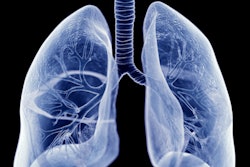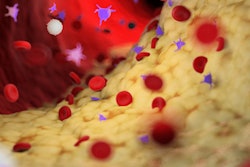
By showing a strong link between ischemic core growth and blood flow in the brain's collateral blood vessels, CT angiography (CTA) can identify stroke patients who are more likely to benefit from endovascular thrombectomy (EVT) to restore blood flow, according to research published November 2 in Radiology.
Endovascular thrombectomy effectively treats large-vessel occlusions, but its value is limited if physicians are unable to determine which patients require the procedure immediately and who can wait. They need to know how rapidly the brain injury -- the ischemic core -- is growing.
The growth rate of the ischemic core is likely to depend heavily on the extent of collateral circulation, which can significantly vary among patients who have suffered a stroke, according to investigators from Massachusetts General Hospital. These alternative vessels compensate for the reduced blood flow that occurs when a person suffers a large-vessel occlusion stroke.
The researchers examined results from 31 patients with large-vessel occlusion stroke who upon admission underwent CTA. They found a strong link between growth of the ischemic core and blood flow in the collateral blood vessels. They strongly associated a symmetric collateral pattern with slow-growing, highly treatable ischemic cores.
"Ischemic core volume is one of the strongest determinants of 90-day outcomes, even among patients who undergo EVT," wrote the researchers, led by Dr. Robert Regenhardt, PhD. "In our study, worse collaterals were an independent determinant of larger ischemic core volume at presentation, even when controlling for other variables including occlusion site, NIHSS [NIH stroke scale] score, and age."
They also stated, "Where perfusion imaging and MRI are unavailable, the collateral pattern assessed with CT angiography (CTA) at presentation may be an appropriate proxy for ischemic core volume and IGR [ischemic core growth rate]."
In order to better determine which patients are the best candidates for EVT, the researchers assessed whether a symmetric collateral pattern at CTA would help identify patients who had smaller ischemic core volumes, a slower ischemic core growth rate, and a 24-hour ischemic core volume less than 50 cm3 (selected a priori as conservative targets used previously in clinical trials) among patients with large-vessel occlusions not treated with reperfusion therapies.
Collateral patterns are important, the scientists indicated, because of their close relationship to clinical outcomes after stroke, which are often difficult to predict. They determined the collateral patterns by visually reviewing the maximum intensity projection arterial-phase CTA images, which they classified as symmetric, malignant, or "other."
They considered a symmetric pattern as contrast-enhancement viewed with similar or near-similar conspicuity of the ischemic compared with the contralateral nonischemic middle cerebral artery territory at risk. A malignant pattern was defined as no-contrast-enhancement viewed over at least 50% of the middle cerebral artery territory at risk. "Other" was any additional pattern, rated as intermediate between symmetric and malignant. The collateral pattern itself was classified as symmetric or malignant if at least one reader gave one of these ratings, and the second reader gave a rating of "other," according to the investigators.
Ischemic cores with reduced diffusivity were outlined visually by applying diffusion-weighted imaging and apparent diffusion coefficient maps from the same time point.
Of the 31 patients examined, 45% collateral images were symmetric, 13% were malignant, and 42% were "other." Symmetric collaterals had a sensitivity of 87% (13 of 15), and a specificity of 94% (15 of 16) for 24-hour ischemic core volume less than 50 cm3.
The researchers found by comparing collateral patterns that there were different ischemic core volumes and IGRs at multiple points. Symmetric collateral patterns from CT angiography were associated with smaller ischemic core volumes and slower ischemic lesion growth, which had been determined using diffusion-weighted MRI.
As an independent determinant of both presentation and 24-hour IGR, collateral pattern may be useful when triaging patients for EVT, especially where MRI and CT perfusion are unavailable. Further study of outcomes is warranted, the researchers added.



















